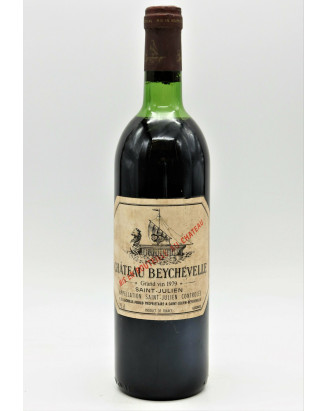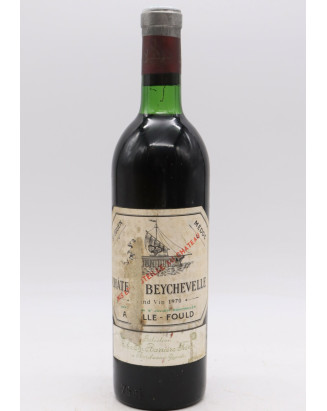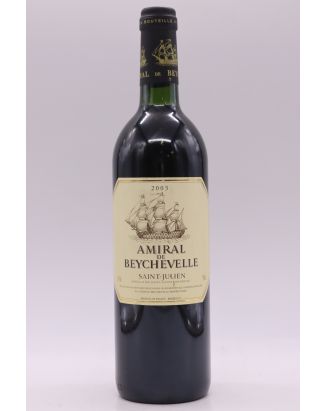











The history of Château Beychevelle dates back to 1565, when Bishop François de Foix-Candale built the first edifice on these prestigious lands. However, it was under the aegis of Jean-Louis Nogaret de La Valette, Duke of Épernon and Admiral of France, that the estate flourished. According to legend, ships sailing on the Gironde would lower their sails as a sign of allegiance when passing in front of the duke's lands. This gesture gave birth to the name "Beychevelle", which means "Lower sail" in Gascon.
The château then traversed the centuries, passing through the hands of influential families, including the Dukes of Épernon, the Marquises of Brassier, and the Heine family, who participated in the expansion and embellishment of the estate. In 1855, during the famous Bordeaux wine classification, Château Beychevelle was crowned 4th Classified Growth of Saint-Julien, an honour that confirms its exceptional status.
In the 1970s, the estate was directed by Aymar Achille-Fould, before passing under the leadership of Grands Millésimes de France in 1989, now owned equally by the Castel and Suntory groups. Thanks to numerous renovations, including a brand new winery inaugurated in 2017, Château Beychevelle has continuously improved the quality of its wines, whilst preserving its legendary heritage.
The 2016 and 2015 vintages of Château Beychevelle were awarded a score of 95/100 by Robert Parker, underlining the finesse and elegance of this Saint-Julien cru classé.
The vineyard of Château Beychevelle spans 90 hectares of the left bank, in an exceptional environment composed of deep Garonne gravels, ideal for cultivating Cabernet Sauvignon, the king grape variety of the Médoc. This privileged terroir, located on the edge of the Gironde, plays a key role in the estate's climate regulation. The gravels, by releasing the heat stored during the day, allow the grapes to ripen in optimal conditions, while the proximity to the estuary protects the vines from spring frosts.
The vineyard is composed mainly of Cabernet Sauvignon (57%), complemented by 40% Merlot and 3% Petit Verdot. The average age of the vines is 30 years, thus ensuring a beautiful concentration of aromas in the grapes. Planted at high density, the vines, thanks to a deep root system, draw nutrients necessary for their development from deep in the soil, while being able to cope with periods of summer drought.
This terroir, coupled with sustainable cultivation practices certified ISO 14001, guarantees respect for the environment and preservation of local biodiversity. Part of the vineyards is even cultivated organically, reflecting the estate's sustainable commitment.
The winemaking process at Château Beychevelle reflects the perfect alliance between tradition and innovation. The harvest is carried out manually, with a rigorous sorting of the bunches to select only the highest quality grapes. Vinification is carried out on a plot-by-plot basis, allowing the full expression of the richness of the estate's different terroirs.
Since 2017, the estate has had an ultra-modern winery, designed by architect Arnaud Boulain. This winery, with its large glass walls, offers transparency in the winemaking process, symbolising both the technical excellence and architectural beauty of the estate.
Fermentations take place in 59 stainless steel vats of varying sizes, adapted to the different plots of the vineyard. Temperature control and gentle extractions allow for the preservation of the finesse of the aromas and the structure of the tannins. The wines are then aged in French oak barrels, 50% of which are new, for 18 months. This method ensures beautiful aromatic complexity and a silky structure, while allowing the wines to develop their ageing potential.
Château Beychevelle produces several wines, all imbued with great finesse and elegance characteristic of the great wines of Saint-Julien.
Château Beychevelle
The estate's grand vin, Château Beychevelle, comes from the best plots and the oldest vines. Renowned for its elegance and aromatic complexity, it offers a beautiful tannic structure, combining power and finesse. This wine reveals aromas of black fruits, blackcurrant and blackberry, complemented by spicy notes and touches of vanilla from its barrel ageing. With ageing potential of several decades, it fully reveals itself after about ten years.
Amiral de Beychevelle
The estate's second wine, Amiral de Beychevelle, is mainly produced from young vines. It benefits from the same care as its elder sibling, with rigorous vinification and traditional ageing. More accessible in its youth, it reveals a beautiful liveliness and fruity aromas. This wine, less complex than the grand vin, can be enjoyed in its early years, but also has good ageing potential.
Brulières de Beychevelle
The Brulières de Beychevelle vineyard, located a few kilometres from the main estate, benefits from a cooler climate, less influenced by the Gironde estuary. A blend of Cabernet Sauvignon and Merlot, this wine offers a fruity and fresh profile, with a beautiful Médoc typicity. Vinified in a separate winery, it benefits from the same attention as the estate's other wines.
Saint-Julien, a flagship appellation of the Médoc in Bordeaux, is renowned for its red wines of great finesse and longevity. Certain vintages particularly stand out for their exceptional quality, offering powerful, elegant and complex wines. Among the finest vintages, one finds years such as 1975, 1982, 1985, 1986, 1989 and 1990, which are true benchmarks for connoisseurs of age-worthy wines. More recent years have not been left behind, with notable vintages such as 1995, 1996, 2000, 2003, 2005, 2008, 2009, 2010, and 2012, all praised for their balance and ageing potential. The years 2014, 2015, 2016, 2017, 2018, 2019 and 2020 also distinguish themselves through their richness and complexity, continuing to make Saint-Julien an essential reference in the world of wine.
Discover the full range of Fourth Classified Growths from Bordeaux, each one representing the richness of the Médoc's prestigious terroirs. In Saint-Julien, explore the wines of Château Beychevelle, Château Branaire-Ducru, and Château Talbot. In Pauillac, Château Duhart-Milon offers wines with the typical character of the appellation, while Château Lafon-Rochet in Saint-Estèphe provides robust vintages. In the Haut-Médoc, Château La Tour Carnet stands out, while Margaux's reputation is upheld by estates such as Château Marquis de Terme, Château Pouget, Château Prieuré-Lichine, and Château Saint-Pierre. Each of these estates reflects, in its own way, the unique identity of the Fourth Growths.
Château Beychevelle embodies the excellence of Bordeaux wines, combining tradition, innovation and respect for the environment. Thanks to its exceptional terroir and rich history, this Fourth Classified Growth of Saint-Julien produces wines of great finesse that seduce enthusiasts around the world. Whether through its grand vin, the Amiral de Beychevelle or the Brulières, each wine expresses all the complexity and elegance of this unique terroir.